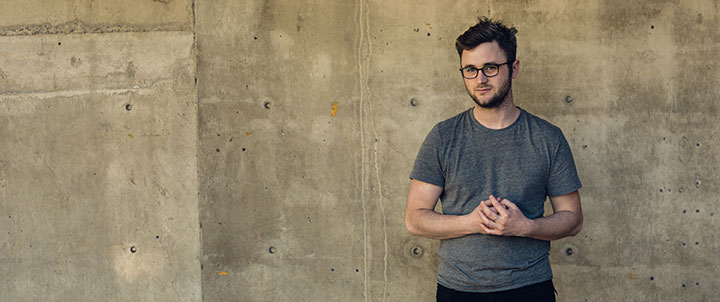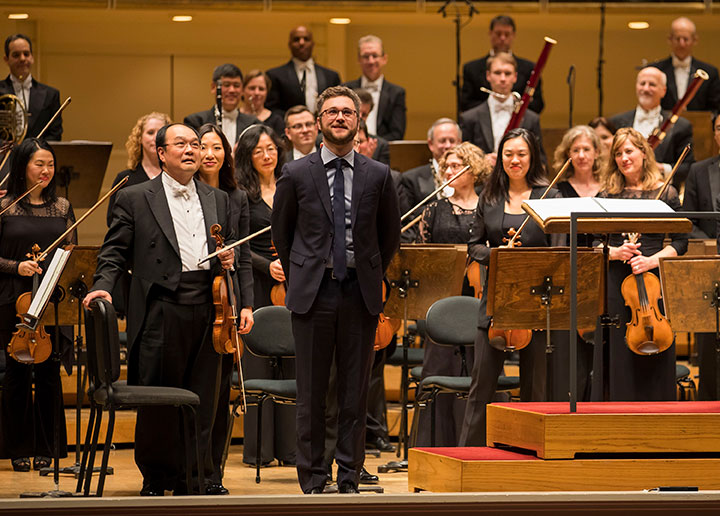By Dennis Polkow
Several concerts on the just-concluded 2017 Ravinia season were devoted to the music of John Adams in celebration of the American composer laureate’s 70th birthday year. But there is another Adams in town, John’s son Samuel Adams, who is beginning his third and final season as composer-in-residence at the Chicago Symphony Orchestra. Along with co-composer-in-residence Elizabeth Ogonek, Adams is also co-curator of the CSO’s MusicNOW series, which is celebrating its 20th anniversary this season.
Adams and Ogonek are the second pair of young composers chosen by CSO music director Riccardo Muti. The composer-in-residence program began 30 years ago, attaching a single well-established composer with the orchestra for several years, but with his inaugural choice of Mason Bates and Anna Clyne, Muti began a template of using the program as a short-term duo apprenticeship of composer collaboration with the CSO. Adams was chosen on the basis of his own scores, not his parentage.
Sitting down for a conversation on a hot day at Orchestra Hall, Adams admits that his upbringing was not a typical one, and that “John and I are both very different musicians and very different composers. Growing up, of course, I was aware of John’s musical life and what he was involved with. So on a musical and a familial level, to be a young individual interested in music and in finding a way to communicate via music, it’s an amazing privilege to be in a nuclear family that spends all of its time thinking and talking about art and about the possibilities and challenges and the hurdles and the economics and every aspect of it. It’s not just my Dad; my mother is an incredible artist—she’s a photographer. And my sister is an incredible painter—a really, really talented individual. It meant that when I was a little kid I was talking about Agnes Martin, Stockhausen, whatever. So of course there is, I don’t know if I want to say advantage, but a privilege to be a young artist in a family of young artists.
“The typical narrative you get, especially in America, is the 18-year old kid goes off to college and says, ‘Hey, Mom and Dad, I want to be a composer,’ and they say, ‘No, are you kidding me? You’re going to study computer science!’ And it was kind of like the opposite for me: ‘Hey Mom and Dad, I think I’m really interested in architecture, engineering, and computers.’ And they were like, ‘You’re kidding me! You’re going to write!’ Of course, I am exaggerating. But you can understand from their perspective, having spent 18 years watching me grow and doing whatever they could to provide a platform for me to do what I needed to do, and then to back off when they could tell that I was rebelling: I quit piano and started contrabass and began participating in the community of free improvisers. They also recognized the importance of rebellion, or at least, back then, what I thought was rebellious.”
How curious, given that John Adams was also rebellious early on.
“Yeah, that is also an interesting position to be in because, being a young artist, you can’t help but want to rebel a little bit. John is, I don’t want to say he’s not so much a rebellious individual anymore, but certainly he’s now part of the world of institutionalized classical music.”
His rebellion became standard.
Adams laughs. “Well, that happens with everyone. It happened with Cage, you know? Now when my students look at 4'33" they’re like, ‘Oh, that’s so old-fashioned’ because there’s a score, a duration, and ‘Published by Peters’ or whoever the publisher of Cage’s works were. And it was done in a traditional setting, with a performer engaging a traditional decorum.”
Adams’s own rebellion was that “I grew up playing classical piano, and then I played contrabass and decided that I wanted to start playing jazz and started improvising a lot more. And then I went to Stanford where I studied at CCRMA [Center for Computer Research in Music and Acoustics], which is like the IRCAM of the West Coast, and learned about digital signal processing and acoustics. The desire to compose was the logical conclusion of a very multifaceted musical upbringing.
“Naturally, as a 20-year-old I felt as though I needed to synthesize my different experiences; as a pianist, someone who had spent so much time in the classical tradition playing Beethoven, Bach, and Haydn; as someone who was called to play three-hour gigs on the contrabass in San Jose playing standards. And then as someone who spent a lot of time in a weird little research institution at Stanford dissecting sound and trying to understand it from a different perspective. From a kind of more systematic perspective, I should say. And composing music was like the process that allowed me to synthesize every aspect of my musical life.”
Might Adams have become a performer, or have gone more into the physics of sound?
“There was a period in my life where I really thought that I was going to be a jazz bass player. That’s really what I thought I was going to do. But I felt creatively stifled, which is not to say that playing contrabass is a stifling activity.”
Was it the genre? Was it tonality?
“It was the physicality of the instrument, in that after playing a three-hour gig, I had to somehow be okay with the fact that I was playing quarter notes. Like for 95 percent of the time. Then when I finally got to solo, everyone in the club was like, ‘Oh, this is not very interesting because it’s in a low register and there’s so much ambient noise that we cannot hear the bass player anyways.’ And then the actual expressive range of the instrument is encumbered by the actual physicality of the instrument.
“I felt that if I was a saxophone or a piano player, I probably wouldn’t have ended up composing. I really just felt that I wanted to say so much more and I just couldn’t. And I was a pretty good bass player. I had facility. And I know I love doing that, but I felt as an artist that unless I started to compose, I felt like it was not fulfilling. I think it’s maybe why there are so many incredible composers who are bass players: Charles Mingus, Dave Holland. I don’t necessarily want to speak for them, but a part of me thinks that maybe they encountered that same kind of friction.”
Adams went on to Yale and completed a master’s degree in composition, a traditional move for someone with as unusual a background as his. “I am not a maverick. Not in that regard. I’m really glad I did. The program was very relaxed and open-ended. They gave us a lot of space to do what we needed to do, not only as composers but as multifarious 21st-century musicians. So I had free rein to teach electronic music and to lead a jazz ensemble that I helped to create, and I was going to New York all the time to hear concerts and gig with a composer/performer friend of mine.
“I think that Martin Bresnick, who runs the composition program at Yale, was and continues to be interested in composers who exhibit a multifarious set of influences and who haven’t yet figured things out. I think that’s what he’s really good at, actually: getting composers to find the commonalities between ways of making music that may seem at first completely unrelated. He probably was interested in me for that reason. He saw the computer side of me; he saw the jazz side and the classical pianist side. Actually, I remember Ezra Laderman during my interview—who, bless his soul, passed away a couple of years ago—he just thought it was the funniest thing when he asked me what I was up to musically, like what my most recent music activities were. I told him, ‘Well, two days ago, right before I came here, I performed Schoenberg’s Sechs kleine Klavierstücke for a very small group of piano students at Stanford. Then later that day I was playing electric bass with a rap group and we opened for this rapper Mos Def.’”
 When an email arrived from the Chicago Symphony Orchestra soliciting Adams to send some scores to be considered as a composer-in-residence for the CSO, Adams saw a unique opportunity. “I was aware of this position because I am of the same generation of Mason [Bates] and Anna [Clyne] and was aware of their work. And I had been listening to the CSO since I was a little kid. I mean, I love listening to those Boulez recordings. But I also thought of Chicago as the town that gave birth to the AACM and the Art Ensemble and then you have these groups like Dal Niente, these smaller kind of self-governed ensembles that do really hardcore stuff.
When an email arrived from the Chicago Symphony Orchestra soliciting Adams to send some scores to be considered as a composer-in-residence for the CSO, Adams saw a unique opportunity. “I was aware of this position because I am of the same generation of Mason [Bates] and Anna [Clyne] and was aware of their work. And I had been listening to the CSO since I was a little kid. I mean, I love listening to those Boulez recordings. But I also thought of Chicago as the town that gave birth to the AACM and the Art Ensemble and then you have these groups like Dal Niente, these smaller kind of self-governed ensembles that do really hardcore stuff.
“Off the top of my head, unless I’m forgetting something very obvious, obviously there is a position with the New York Phil. And then there’s a position Cleveland has with the opportunity for a young composer to write a piece. There isn’t this kind of position that is so involved and so multifaceted that it requires whoever holds the post to not only write, but to also curate a concert series. There’s nothing like that in the country right now.”
For Adams, “The idea of working with 80, 90, 100 musicians who have spent their whole entire lives perfecting a 19th-century orchestral sound and figuring out how to harness what they know and the hundreds of thousands of musical hours of experience and the just insane amount of expertise and knowledge to make something new is a challenge. That’s what also makes it very exciting. As far as sound as and far as pushing the sound of the orchestra forward, there’s a lot to explore. I really don’t like this idea that there’s no need to use an orchestra because we can make any sound with a computer. What’s so amazing about working with a large group of people is that the complexity of the sound is never the same with any two performances, which is why live music is exciting. It’s not just about the sound itself but the fact that the sound itself can change at any minute depending on the subtleties and emotional nuances of the people onstage. That’s why I do it.”
Adams’s many words of love was given its world premiere by Riccardo Muti and the Chicago Symphony Orchestra in March of 2017 and will be part of the CSO’s East Coast tour in February 2018, including performances at the Kennedy Center and Carnegie Hall. The 20th anniversary season of MusicNOW kicks off October 2 and concludes May 21 with Esa-Pekka Salonen conducting world premieres by Adams and Elizabeth Ogonek.

